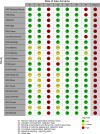Efficacy and safety of misoprostol versus oxytocin for labor induction in women with prelabor rupture of membranes: a meta-analysis
- PMID: 40259229
- PMCID: PMC12012967
- DOI: 10.1186/s12884-025-07592-2
Efficacy and safety of misoprostol versus oxytocin for labor induction in women with prelabor rupture of membranes: a meta-analysis
Abstract
Background: Prelabor rupture of membranes (PROM) complicates 8% of pregnancies, often necessitating labor induction to prevent maternal and neonatal complications. Misoprostol, a cost-effective prostaglandin, has been proposed as an alternative to oxytocin for labor induction in PROM cases, but its efficacy and safety remain debated.
Methods: The PubMed, Web of science, Embase, Google scholar, ClinicalTrials.gov, and Cochrane Library databases were searched on January 25, 2025. Randomized controlled trials (RCTs) comparing misoprostol and oxytocin for labor induction in term PROM were eligible. The primary outcomes were vaginal birth within 24 h and the induction to delivery interval. Secondary outcomes included the duration of second stage of labor, the induction to active labor, cesarean section, postpartum hemorrhage (PPH), and other maternal/neonatal complications.
Results: Data from 20 RCTs involving 2,980 participants were analyzed. Misoprostol significantly reduced the induction-to-delivery interval and the duration of the second stage of labor compared to oxytocin (WMD = -62.82, 95% CI (-110.56, -15.08); WMD = -4.29, 95% CI (-8.05, -0.52), respectively). It also lowered the risk of PPH (OR = 0.63, 95% CI (0.41, 0.98)). However, no significant differences were found in other outcomes between misoprostol and oxytocin.
Conclusions: Misoprostol is a viable alternative to oxytocin for labor induction in PROM, offering shorter labor durations and reduced PPH risk without compromising maternal and neonatal outcomes. Further researches are needed to optimize dosing, administration routes, and assess maternal satisfaction.
Keywords: Efficacy; Labor induction; Meta-analysis; Misoprostol; Oxytocin; PROM; Prelabor rupture of membranes; Safety.
© 2025. The Author(s).
Conflict of interest statement
Declarations. Ethics approval and consent to participate: The study was approved by the Institutional Review Board (IRB) of the First Hospital of China Medical University (NO. 2025034 on Jan 27, 2025). The study followed the principles of the Declaration of Helsinki. The IRB of the First Hospital of China Medical University waived the need for informed consent because this was a meta-analysis study based on published data. Consent for publication: Not applicable. Competing interests: The authors declare no competing interests.
Figures
Similar articles
-
Is there a role for oral misoprostol in labor induction for prelabor rupture of membranes at term?BMC Pregnancy Childbirth. 2025 Apr 23;25(1):467. doi: 10.1186/s12884-024-07040-7. BMC Pregnancy Childbirth. 2025. PMID: 40269788 Free PMC article.
-
EFFECTIVENESS AND SAFETY OF 2-HOURLY 20 MCG ORAL MISOPROSTOL SOLUTION COMPARED TO STANDARD INTRAVENOUS OXYTOCIN IN LABOUR INDUCTION DUE TO PRE-LABOUR RUPTURE OF MEMBRANES AT TERM: A RANDOMISED CLINICAL TRIAL AT KENYATTA NATIONAL HOSPITAL.East Afr Med J. 2014 Sep;91(9):303-10. East Afr Med J. 2014. PMID: 26866082 Clinical Trial.
-
[Term Prelabor Rupture of Membranes: CNGOF Guidelines for Clinical Practice - Methods for Inducing Labor].Gynecol Obstet Fertil Senol. 2020 Jan;48(1):48-58. doi: 10.1016/j.gofs.2019.10.014. Epub 2019 Oct 25. Gynecol Obstet Fertil Senol. 2020. PMID: 31669528 French.
-
Induction of labour with a favourable cervix and/or pre-labour rupture of membranes.Best Pract Res Clin Obstet Gynaecol. 2003 Oct;17(5):795-809. doi: 10.1016/s1521-6934(03)00067-1. Best Pract Res Clin Obstet Gynaecol. 2003. PMID: 12972015 Review.
-
[Term Prelabor Rupture of Membranes: CNGOF Guidelines for Clinical Practice - Timing of Labor Induction].Gynecol Obstet Fertil Senol. 2020 Jan;48(1):35-47. doi: 10.1016/j.gofs.2019.10.015. Epub 2019 Oct 25. Gynecol Obstet Fertil Senol. 2020. PMID: 31669525 Review. French.
References
-
- Committee on Practice B-O. ACOG practice bulletin 188: prelabor rupture of membranes. Obstet Gynecol. 2018;131(1):e1–14. - PubMed
-
- Ismail AQ, Lahiri S. Management of prelabour rupture of membranes (PROM) at term. J Perinat Med. 2013;41(6):647–9. - PubMed
-
- Gerdes JS. Clinicopathologic approach to the diagnosis of neonatal sepsis. Clin Perinatol. 1991;18(2):361–81. - PubMed
-
- Prelabor Rupture of Membranes. ACOG practice bulletin, number 217. Obstet Gynecol. 2020;135(3):e80–97. - PubMed
-
- Chien E, Mercer BM. Preterm premature rupture of the membranes in the Twenty-First century. Obstet Gynecol Clin North Am. 2020;47(4):xiii–xiv. - PubMed
Publication types
MeSH terms
Substances
Grants and funding
LinkOut - more resources
Full Text Sources





